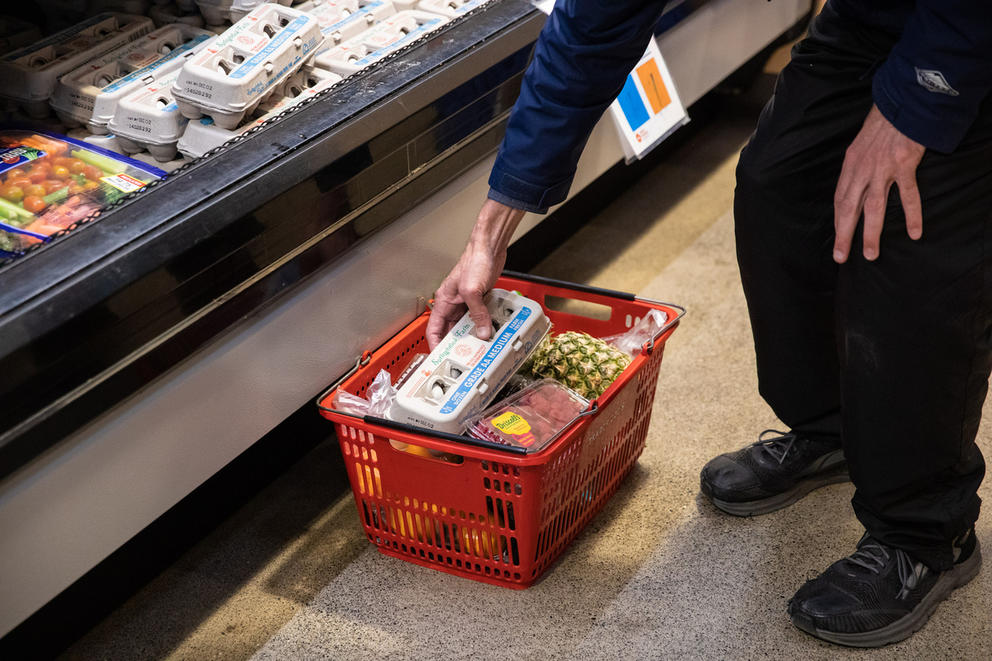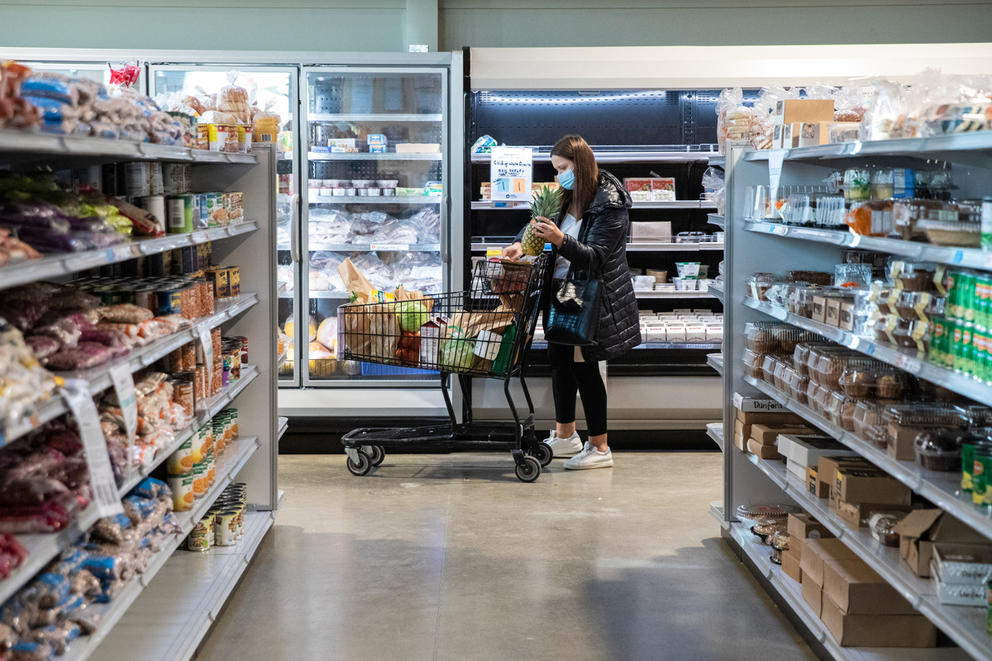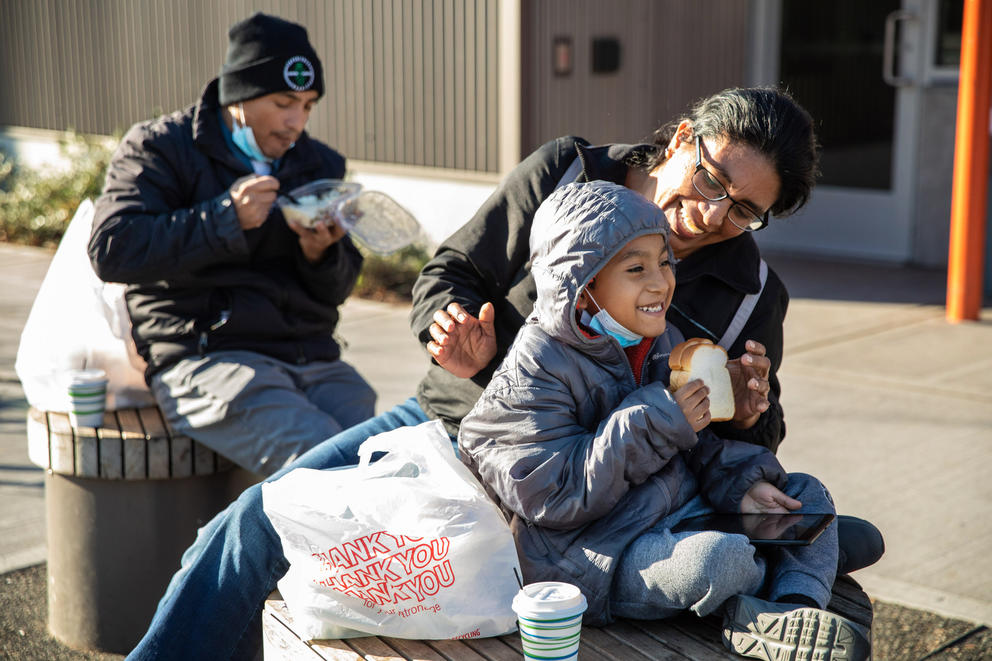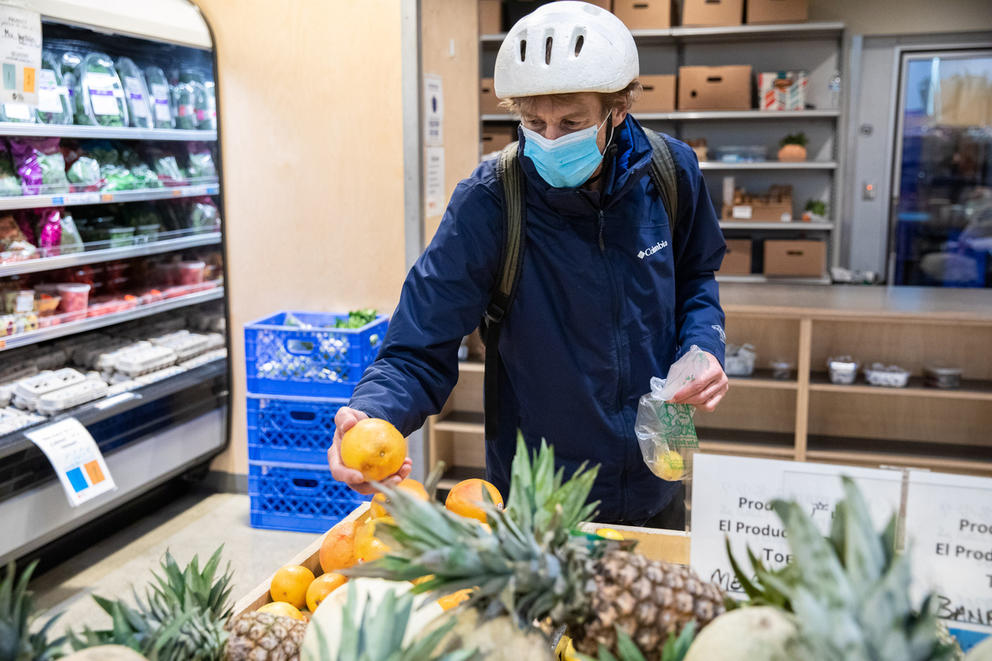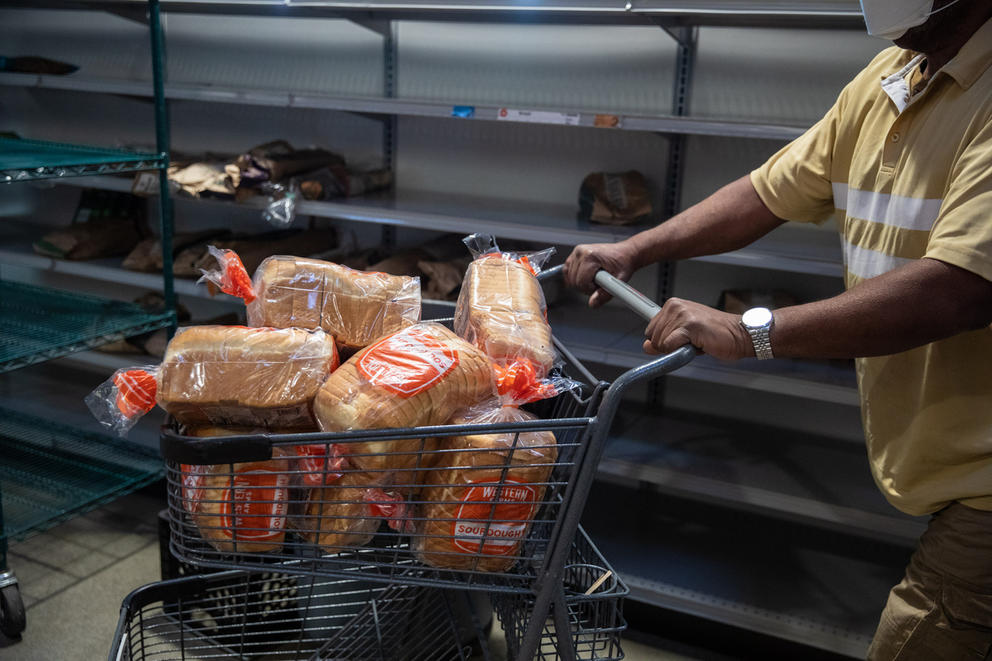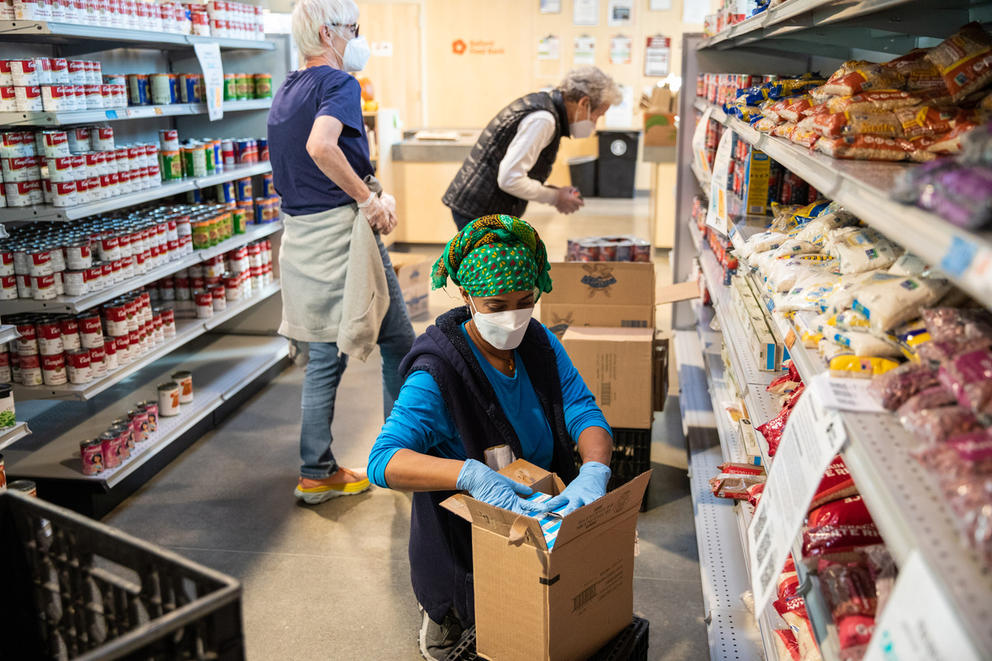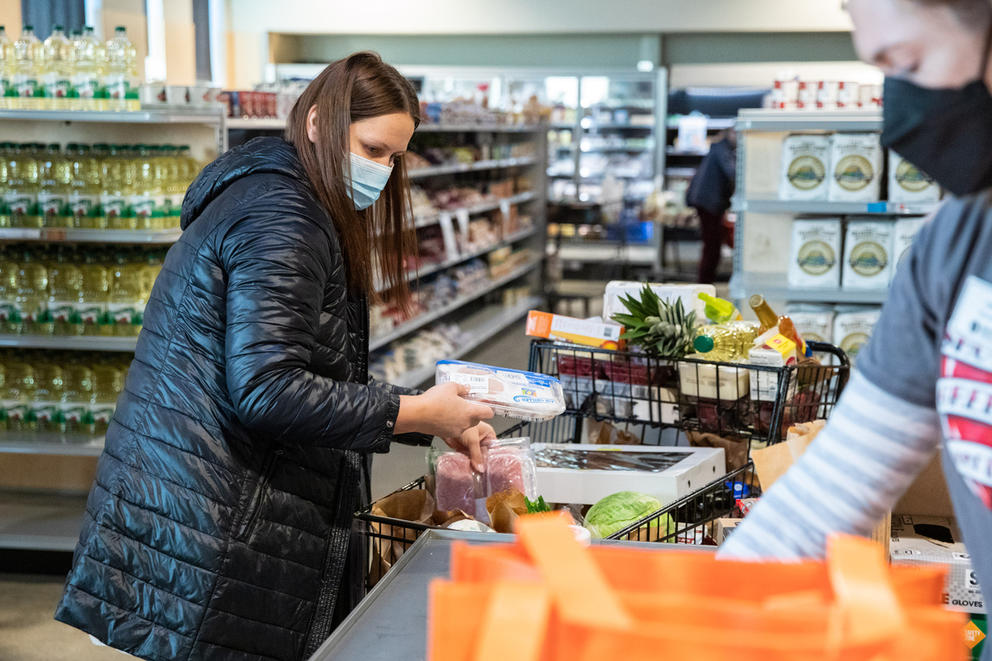Para leer este artículo en español, haga clic aquí.
“It is very important that people who do not have food to survive are being supported. That is very wonderful,” said Bucardo through a Spanish-to-English translation app on his phone.
Seattle’s food banks have, for decades, been there to help individuals and families like Bucardo’s weather hard times, when a shortage of money often means skipping meals to ensure the rent and bills get paid.
During the pandemic, a drastically higher number of Seattleites turned to food banks, and that demand has continued apace even as broader health and economic conditions have improved. Pre-pandemic, Ballard Food Bank served about 3,200 clients a month through its grocery and home delivery service. Now it serves around 6,200 people each month. The Rainier Valley Food Bank also nearly doubled its clientele, from about 600 people a week pre-pandemic to more than 1,000 in-person visits and home deliveries.
Now, rising inflation and higher food and fuel costs are wreaking further havoc on Seattle’s food banks. Not only are even more people turning to food banks for help, the nonprofits are also facing a double-edged sword: fewer food donations from grocery stores, wholesalers and other suppliers, and much higher out-of-pocket costs to keep their shelves stocked.
All this comes as food banks are working to reimagine their model to provide healthier food choices and better meet their clients’ specific cultural needs; reduce the stigma associated with receiving free food; and take a more intersectional approach to safety-net issues like food insecurity, homelessness and affordable housing.
Inflation’s impact
According to the Consumer Price Index, the cost of consumer goods and services rose 7.7% from October 2021 to October 2022. Altogether, groceries are up 12.4% year-over-year with staples such as cereals, breads and dairy up nearly 16%.
That alone has impacted food banks’ ability to operate. But tighter food supplies and higher fuel costs have added up to make things even more challenging.
Food banks often stock their shelves with leftovers from grocery stores and other food suppliers, such as bread just past its sell-by date. Food shortages have impacted retailers’ supply of some foods, which translates to fewer groceries for food banks to collect.
Even before the pandemic, food banks had to purchase some of their food and supplies from wholesalers. But until recently, Ballard Food Bank never had to buy bread and rarely had to buy eggs, said Jen Muzia, the nonprofit’s executive director. Now they’re purchasing most of the bread and eggs on their shelves.
Gloria Hatcher-Mays, Rainier Valley Food Bank’s executive director, said some of their food suppliers have recently tacked on a delivery fee to offset rising fuel costs. Similarly, higher fuel costs have hit statewide nonprofit Northwest Harvest’s pockets as they deliver food and supplies to their food-bank partners around Washington.
Budgetary woes
The impact is significant. Ballard Food Bank spent around $300,000 a year purchasing food pre-pandemic. Now, Muzia said she’s budgeted $1.5 million for grocery purchases for the 2022-2023 fiscal year to offset higher food costs while still meeting the increased demand.
Seattle food banks are also worried about losing some funding from the city. Human service providers such as food banks, homeless outreach workers and many others rely on contracts from the City of Seattle to help cover their costs. Those contracts have long lagged behind cost of living increases, leading to low pay for challenging work and high turnover in the human services sector.
In 2019, the City Council passed a law to peg contract size increases to inflation. Those contracts were supposed to increase by 7.6% in 2023, but Mayor Bruce Harrell’s proposed budget would cap increases to 4% to save money in the face of a growing budget deficit. Several council members have offered amendments to fully fund the 7.6% contract increases, but the budget won’t be finalized until later this month.
Pandemic-era federal assistance helped offset some of the growing food insecurity. King County’s $5.4 million Food Security Assistance Program used one-time federal pandemic relief funds to help feed an additional 10,000 people a month. But that program is ending Dec. 31.
Washingtonians enrolled in the SNAP food assistance program also got an additional $175 a month during the pandemic thanks to an infusion of federal money. But that money was contingent on the state having a declared state of emergency, which state and local leaders ended on Oct. 31.
Who needs help
“The money just doesn’t go around when you have to pay for housing, healthcare, utilities,” said Thomas Reynolds, CEO of Northwest Harvest. “You could be evicted or not get medical attention you need or utilities could be shut off. There’s no real penalty for skipping meals. We worry about people’s long-term health effects by not having access to food.”
Chris, a young adult who recently went back to school, stood in line outside the Ballard Food Bank last Thursday waiting for a number that would determine his place in line when the grocery store opened later in the day. Added tuition costs have left Chris, who didn’t want to share his last name for privacy reasons, with an extremely tight monthly budget. He said going to the food bank not only helps him save money, it’s helping him eat healthier.
“It’s this, or I don’t eat certain things,” he said of visiting the food bank. “My diet’s been better since I started coming here. I’m getting lots of produce.”
Unsurprisingly for a city with a severe and ongoing homelessness crisis, many of Seattle’s food bank clients are homeless. But unhoused residents are far from the only Seattleites who need extra help. Northwest Harvest’s Reynolds said the vast majority of food bank clients are housed, and many are working several jobs to make ends meet.
Reimagining the food bank
Amid surging demand, food banks have also been thinking about how to evolve their models. For example, they are putting more emphasis on supplying more culturally appropriate foods such as halal and kosher foods and vegetable staples like yuca and cactus.
There’s also an effort to rethink the physical space of food banks, both to reduce stigma and to take a more encompassing approach to the social safety net.
In October 2021, the Ballard Food Bank opened a shiny new building. The food bank section was completely redesigned to look like a regular grocery store. There’s a produce section, a dairy case and aisles of dry goods and other supplies.
“We wanted to build a place that fostered dignity and belonging. The old place felt a little like the DMV,” said Muzia.
Making the food bank look like a regular grocery store can help normalize asking for help, she explained.
The new building also houses many other services that people experiencing poverty or homelessness might need. The Kindness Café provides free hot meals for anyone who wants them and a space to hang out indoors. Unhoused residents can use the food bank’s address for mail delivery and services like voter registration. There are also office spaces for service providers who can help connect clients with housing or get a new ID card.
“People often connect first around food,” said Muzia. “Then you start building trust and can work on other things.”
The Rainier Valley Food Bank similarly acts as a one-stop shop for food and some services like getting signed up for the city’s low-income utilities discount. The nonprofit is in the midst of raising money to redesign its physical space as the Ballard Food Bank did.
“[The design] is important in the grand scheme of things,” said Hatcher-Mays. “Self-esteem is a driver of success and revitalization of purpose.”
How to help
There are many ways to help Seattle’s food banks in their time of need. Donating money is one of the most impactful, since food banks are often able to purchase from wholesalers and can focus those purchases on items they need. But Muzia and Hatcher-Mays both said they always welcome direct donations of food and supplies.
Most anyone can also donate their time. Food banks rely heavily on volunteers to sort food, stock the shelves, pack bags for home deliveries, make deliveries and more.
Reynolds said food banks tend to receive the most attention this time of year as people gear up for the holidays. But the nonprofits need help year round.
Find more information about donating and volunteering on the websites of Rainier Valley Food Bank, Ballard Food Bank and Northwest Harvest. Seattle Food Committee, a coalition of food banks and other groups working on food insecurity, also has information about helping food banks throughout the city.
Food banks expect they’re going to need all the help they can get as inflation continues and the threat of a recession looms.
“For the folks we work with and the work that we do, [the pandemic impacts] will have a very, very long tail,” said Hatcher-Mays. “We hope folks keep us top of mind and support their local food banks because this is going to be a rough patch for a bit while we get people back on their feet and stabilize the economy, and we want to make sure nobody gets lost in that process.”

